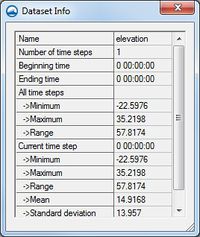SMS:Dataset Info: Difference between revisions
From XMS Wiki
Jump to navigationJump to search
(Created page with "A dataset consists of a set of values. It is often useful to be able to get general information about the dataset. SMS displays this information in the "Dataset Info" dialog whi...") |
No edit summary |
||
| (6 intermediate revisions by the same user not shown) | |||
| Line 1: | Line 1: | ||
A dataset consists of a set of values. It is often useful to be able to get general information about the dataset. SMS displays this information in the | [[Image:SMS Dataset Info.jpg|thumb|200 px|''Dataset Info'' dialog]] | ||
A dataset consists of a set of values. It is often useful to be able to get general information about the dataset. SMS displays this information in the '''Dataset Info''' dialog which is invoked by right-clicking on the dataset and selecting the '''Info...''' command. | |||
The dialog displays the following information: | The dialog displays the following information: | ||
*Name | *''Name'' – display the name of the dataset | ||
*Number of time steps | *''Number of time steps'' – displays the number of discrete times represented by the dataset. It will be 1 for a steady state dataset. | ||
*Beginning time | *''Beginning time'' – this shows the lowest time for any discrete time represented by the dataset. For steady state datasets, this will be 0.0. It will be displayed in the ''information'' dialog according to the current time settings. | ||
*Ending time | *''Ending time'' – this shows the largest time for any discrete time represented by the dataset. For steady state datasets, this will be 0.0. It will be displayed in the dialog according to the current time settings. | ||
*All time steps statistics | *''All time steps statistics'' – this displays the minimum, maximum and range of values for all values in the dataset across all times represented by the dataset. | ||
*Current time step statistics | *''Current time step statistics'' – this displays the minimum, maximum, range, mean and standard deviation of values for all values in the current or actively selected time. | ||
*Reference Time | *''Reference Time'' – If a dataset is referenced to a universal date/time, it often will be stored relative to a "zero time". SMS allows the user to specify a "zero time" for a project that will be applied to all datasets that do not have their own reference. This field displays the "zero time" for this dataset if it exists. | ||
Latest revision as of 16:08, 31 August 2015
A dataset consists of a set of values. It is often useful to be able to get general information about the dataset. SMS displays this information in the Dataset Info dialog which is invoked by right-clicking on the dataset and selecting the Info... command.
The dialog displays the following information:
- Name – display the name of the dataset
- Number of time steps – displays the number of discrete times represented by the dataset. It will be 1 for a steady state dataset.
- Beginning time – this shows the lowest time for any discrete time represented by the dataset. For steady state datasets, this will be 0.0. It will be displayed in the information dialog according to the current time settings.
- Ending time – this shows the largest time for any discrete time represented by the dataset. For steady state datasets, this will be 0.0. It will be displayed in the dialog according to the current time settings.
- All time steps statistics – this displays the minimum, maximum and range of values for all values in the dataset across all times represented by the dataset.
- Current time step statistics – this displays the minimum, maximum, range, mean and standard deviation of values for all values in the current or actively selected time.
- Reference Time – If a dataset is referenced to a universal date/time, it often will be stored relative to a "zero time". SMS allows the user to specify a "zero time" for a project that will be applied to all datasets that do not have their own reference. This field displays the "zero time" for this dataset if it exists.
Related Topics
SMS – Surface-water Modeling System | ||
|---|---|---|
| Modules: | 1D Grid • Cartesian Grid • Curvilinear Grid • GIS • Map • Mesh • Particle • Quadtree • Raster • Scatter • UGrid |  |
| General Models: | 3D Structure • FVCOM • Generic • PTM | |
| Coastal Models: | ADCIRC • BOUSS-2D • CGWAVE • CMS-Flow • CMS-Wave • GenCade • STWAVE • WAM | |
| Riverine/Estuarine Models: | AdH • HEC-RAS • HYDRO AS-2D • RMA2 • RMA4 • SRH-2D • TUFLOW • TUFLOW FV | |
| Aquaveo • SMS Tutorials • SMS Workflows | ||
